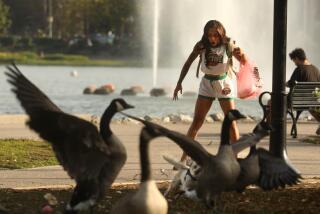Poachers Get Handle on Geese
- Share via
ANCHORAGE — Eighty-year-old Buck Delkettie leaned over and carefully plucked still-warm white goose eggs from a nest lined with gray goose down.
“One, two, three, four, five,” he counted as he carefully placed the large eggs on a bed of moss in the bottom of his plastic bucket. He ignored the hissing, honking and flapping of wings from two Canada geese he had run off the nest.
“Sorry, momma,” the Athabaskan elder said as the female goose honked at him. “She’s mad. ‘You’re taking my babies.’ ”
Delkettie was among about 25 people in the annual hunt for Canada goose eggs recently. The hunt is part of a program to reduce the goose population in Anchorage to 2,000 by the end of 2001. Wildlife officials say the program is right on target.
Volunteers go out about a week later to raid the nests again. Rick Sinnott, a state Department of Fish and Game biologist, said he expects between 300 and 400 eggs to be collected.
Back in the mid-1990s, Anchorage was home to more than 5,000 geese. Populations were doubling every five years, according to the U.S. Fish and Wildlife Service. But in 1995 some geese were sucked into the jet engines of a big AWACS military radar plane at Elmendorf Air Force Base. The crash killed 24 people and forced Anchorage to confront its exploding goose population.
In the 1970s there were just a few hundred geese in Anchorage, so few that in the 1980s someone thought it would be a good idea to introduce about 100 geese into a lake at Ft. Richardson, said Fish and Wildlife biologist Karen Laing.
“People didn’t realize that geese were going to be a problem until the last 20 years all over the country,” she said.
In Illinois, farmers fed up with Canada geese and mallard ducks destroying up to 80% of their corn crop are fighting back by poisoning and shooting the birds.
Farmers in Bucks County, Pa., want to be able to shoot geese on sight that are damaging their crops. The National Audubon Society estimates that the population there has grown from 500 birds 30 years ago to more than 60,000.
In Big Stone, S.D., hunters last winter helped disperse up to 30,000 geese that were congregating on a 360-acre power plant cooling pond.
The Canada goose population in Anchorage grew with its human population. Anchorage’s population grew 38% between 1970 and 1980, and 30% in the next decade.
Homes were built around artificial lakes, and homeowners planted lush lawns of fertilized Kentucky bluegrass that went down to the water’s edge. They kept their lawns neatly mowed--just as geese like it so they can keep a lookout for predators.
“That just happens to be perfect habitat for geese to raise young,” Laing said.
The geese became fat and strong on fertilized grass. More of their young survived. They spent winters in Oregon feeding on grass seed and sod grown for the booming golf course industry, Laing said.
Ridding the municipality’s four airports of geese was the biggest concern. The airports spend about $400,000 a year to establish goose-free zones. Goose-dispersal measures include a cutout of a fox or coyote moved around airport properties, propane cannons, 12-gauge cracker shells, 15mm whistlers and 15mm bangers. Some geese are shot. Goslings are moved to refuges. Grass is kept long. Experiments are underway to find grasses geese don’t like.
Last year about 4,000 geese were removed from Ted Stevens Anchorage International Airport property, near the bog where this year’s goose hunt was held.
“It is now a manageable problem,” said airport operations manager Corky Caldwell.
Special permits will allow the Elders Program of the Southcentral Foundation to donate the eggs to Alaska Natives so they can eat them, as their ancestors once did. The Migratory Bird Treaty Act ordinarily prohibits the collecting of wild bird eggs.
“It tastes like a real egg,” said 62-year-old Yup’ik Eskimo Barb Shetter, who carried two eggs in her bucket. “When you eat wild eggs and then eat chicken eggs, they’re tasteless.”
Delkettie said he doesn’t care for goose eggs but enjoys the hunt.
“Now they can call us egg poachers,” he said, erupting in laughter as he put three more eggs in his bucket. By the end of the morning, he had 22 eggs.
More to Read
Sign up for Essential California
The most important California stories and recommendations in your inbox every morning.
You may occasionally receive promotional content from the Los Angeles Times.













